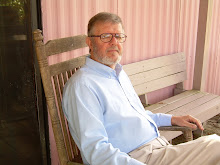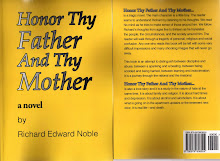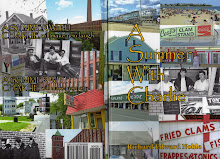The Eastpointer
Oystering the Old Fashioned Way
By Richard E. Noble
If I'm not mistaken, it was after hurricane Elena ran back and forth off the Florida panhandle that we were forced to seek work elsewhere once again. By this time we had a new flat-bottomed Hatfield built boat, a roll-on boat trailer and our trusty Johnson 40 Workhorse model motor.
Our Johnson Workhorse was a pull start, with no tilt and trim, but it was the best working motor we ever had. It took some power to pull that crank rope but it cranked every time on one good pull. It was simple and easy to repair. It even came with an on board tool kit. That was my favorite motor. I'm sure they don't make it any longer. It was too simple and too practical. It was like the old model T - it never stopped. You could fix it yourself, repair parts were cheap and like the old model T, it bored everybody. So they improved it. Now you can buy one that needs to be repaired every time you want to use it, the parts are unaffordable, and no one in the neighborhood can fix it. It fact the man who can repair it has to be a certified electrical engineer. But the worse they make them the more Americans seem to buy them. The miracle of marketing, I guess.
In any case, Cat Point was closed, and the word around town was that the beds were like concrete anyway. One old timer told me that the cure was for a bunch of oyster boats to get out there and pull bedsprings back and forth across the bottom. He said that is what they did back in the “olden” days.
We packed up and went down to Horseshoe Beach. We could have gone to Alabama or Mississippi, but we thought that we would run into fewer problems in Horseshoe. The dealer down there allowed us to park our van camper out in back of his oyster house.
There was a little village of Eastpointers down there. They were in the bushes, out in the woods and out on the islands - any place that could be had for free. Nobody bothered us.
The tides were really something down there. You had to time your trips in and out. If you weren't up early enough in the morning, and the tide had gone out, you didn't get out. If you worked too long into the evening and the tide was gone, you slept out in the woods or on your boat. Carol and I watched the tides. We had some close calls both going out and coming in where we had to climb out of the boat and push it over the shallow areas. But with our new Hatfield flat-bottomed boat, we could float in 6 inches of water with twenty bags of oysters on board. We had a big advantage there.
They had no problem with any of us oyster people down at Horseshoe because they really didn't have any oysters there. They had no cultivated beds, I guess I should say. You had to rig yourself up a rope and chain with a bobber tied to the end that didn't have the chain. You would go out into the bay and then putts around for an hour or two dragging that chain behind your boat. When the chain started grabbing and pulling, you threw out the marker. Then you turned the boat around and pulled up on your marker and dropped in your tongs and scrapped around.
Amazingly enough sometimes we caught 10 or 15 bags on a spot two boat lengths long and one boat length wide. It was oystering the old fashioned way - you earned it.
I don't remember much about the Horseshoe Beach area because, for the most part, all we did was work. But the man down there paid us regularly and the bank cashed his checks. There was a grocery store and a barroom and that was about it. The people who lived there fished, they didn't oyster. So we were no problem to them at all. Most of them couldn't believe how many bags of oysters us Eastpointers brought in every day. They thought we were growing them out there.
As soon as we heard that they were going to let the oystermen back out onto Cat Point we came trucking home. For at least one week, I think we were the only boat out on Cat Point. The bottom was like concrete and it was mighty scrappy - but it was as good as Horseshoe and we were home.
One day channel 6 News pulled up along side us. They wanted to do a story. We told them that we were catching a few - maybe 8 to 12 bags a day and that evening we were on the TV.
Well, everybody from Eastpoint must have been watching in Horseshoe, Alabama and Mississippi because by the end of that next week the oyster boats were once again scattered all over Cat Point. Within a month or two the bottom seemed pretty much back to normal. Oystering was scrappy - but everybody was home. It felt good to see all the boats out on the bay once again. Eastpoint had been like a ghost town for a few months. I don't know what the few local businesses did, but they had to be hurting. In those days Eastpoint and oyster boats was synonymous - no oyster boats, no Eastpoint.
A Little Something is R.E. Noble’s latest creative output. It is a book of poetry with prose. It is for sale on Amazon along with Hobo-ing America, A Summer with Charlie and Honor Thy Father and Thy Mother. Richard Noble is a freelance writer and has been a resident of Eastpoint for 30 years.
skip to main |
skip to sidebar


G.E. Nordell's List of Labor History books
Search This Blog
Popular Posts
-
Bea’s Sandwich Shop Lawrence, Mass - My Hometown By Richard E. Noble Bea’s sandwich shop was a big memory for those of us...
-
John Pierpont Morgan 1837- 1913 By Richard E. Noble “Morgan the Magnificent - If ever there thrived a money potentate whose fortune was p...
-
Jews, God and History By Max I. Dimont Book Review By Richard Edward Noble Max I. Dimont is an ex-shoe salesman and unskilled la...
-
Social Security Commentary By Richard E. Noble The original Social Security legislation was passed in 1935. It covered employees w...
-
IF I WERE A BUTTERFLY By Richard E. Noble If I were a butterfly, I could flap my wings, and fly from flower to flower... Hour... upon hour ....
-
The Hobo Philosopher Rice Cakes – Yummy, Yummy. By Richard E. Noble My wife, over the past 30 years, has probably been on every di...
-
Politically Incorrect Humor/Commentary By Richard E. Noble Obviously, I grew up in the age of political incorrectness. Clearly I was raised ...
-
The Eastpointer Why do mullet jump? By Richard E. Noble Mullet has been a staple of life for decades here in Franklin County. Most other pl...
-
Lawrence – My Hometown Lennie’s on the Turnpike Richard E. Noble Being a jazz buff from early on my favorite nightspot was Lennie’s on the T...
-
Lawrence - My Hometown The Den Rock Drive-in By Richard E. Noble The Den Rock drive-in was on route 114 before the Den restaurant and pa...
Hobo Notes
Licensed book sellers and distributors - buy my books wholesale
Books by Richard Edward Noble. Click on covers below for more info and purchasing instructions.
Bloggin' Be My Life
It's All About Love
A Little Something
Bits and Pieces
A Baker's Dozen
Cat Point - and Them Dang Oyster People
The Eastpointer
A Summer with Charlie - Lawrence
Hobo-ing America
"Just Hangin' Out Ma"
That Old Gang of Mine
Come On-A My House
Standing on the Corner is # 6 in the lawrence My Hometown series.
Honor Thy Father and Thy Mother
Noble Notes on Famous Folks
Mein Kampf - An Analysis of Book One
America on Strike
Talk Radio - Lawrence, Ma. WCCM
Richard Edward Noble

About Me

- Richard Edward Noble
- MY NAME IS RICHARD EDWARD NOBLE. I AM A FREELANCE WRITER AND I HAVE PUBLISHED 12 BOOKS:"THE EASTPOINTER" - SELECTIONS FROM AWARD WINNING NEWSPAPER COLUMN - "A LITTLE SOMETHING" - POETRY WITH PROSE -"HONOR THY FATHER AND THY MOTHER" - A NOVEL ABOUT GROWING UP IN THE NEW ENGLAND MILL TOWN OF LAWRENCE, MASS, "HOBO-ING AMERICA" - A WORKINGMAN'S TOUR OF THE U.S.A. - "A SUMMER WITH CHARLIE" - THE STORY OF A YOUNG SAILOR'S LAST DAYS AT SALISBURY BEACH, "NOBLE NOTES ON FAMOUS FOLKS" - HUMOROUS ANECDOTES ON FAMOUS FOLKS IN HISTORY, "AMERICA ON STRIKE" HISTORY BOOK - A SURVEY OF LABOR STRIKES IN AMERICA; "A BAKER'S DOZEN" A BOOK OF HUMOROUS SHORT STORIES; "JUST HANGIN' OUT, MA" - GROWING UP IN THE 40'S, 50'S AND 60'S IN LAWRENCE, MY HOMETOWN, "TENEMENT DWELLERS" - SEQUEL TO JUST HANGIN OUT, MA; MEIN KAMPF - ANALYSIS OF BOOK ONE - HISTORY. CAT POINT - AND THEM DANG OYSTER PEOPLE - SEQUEL TO THE EASTPOINTER All 12 BOOKS ARE AVAILABLE ON AMAZON.COM, BARNES AND NOBLE AND OTHER INTERNET SOURCES OR FROM NOBLE PUBLISHING. ALL 12 OF MY BOOKS ARE NOW ON KINDLE AT BARGAIN PRICES TOO. IF YOU WOULD LIKE MORE INFORMATION ABOUT DISCOUNTS AND SPECIAL OFFERS E-MAIL ME. MY EMAIL IS ON MY PROFILE PAGE.




































